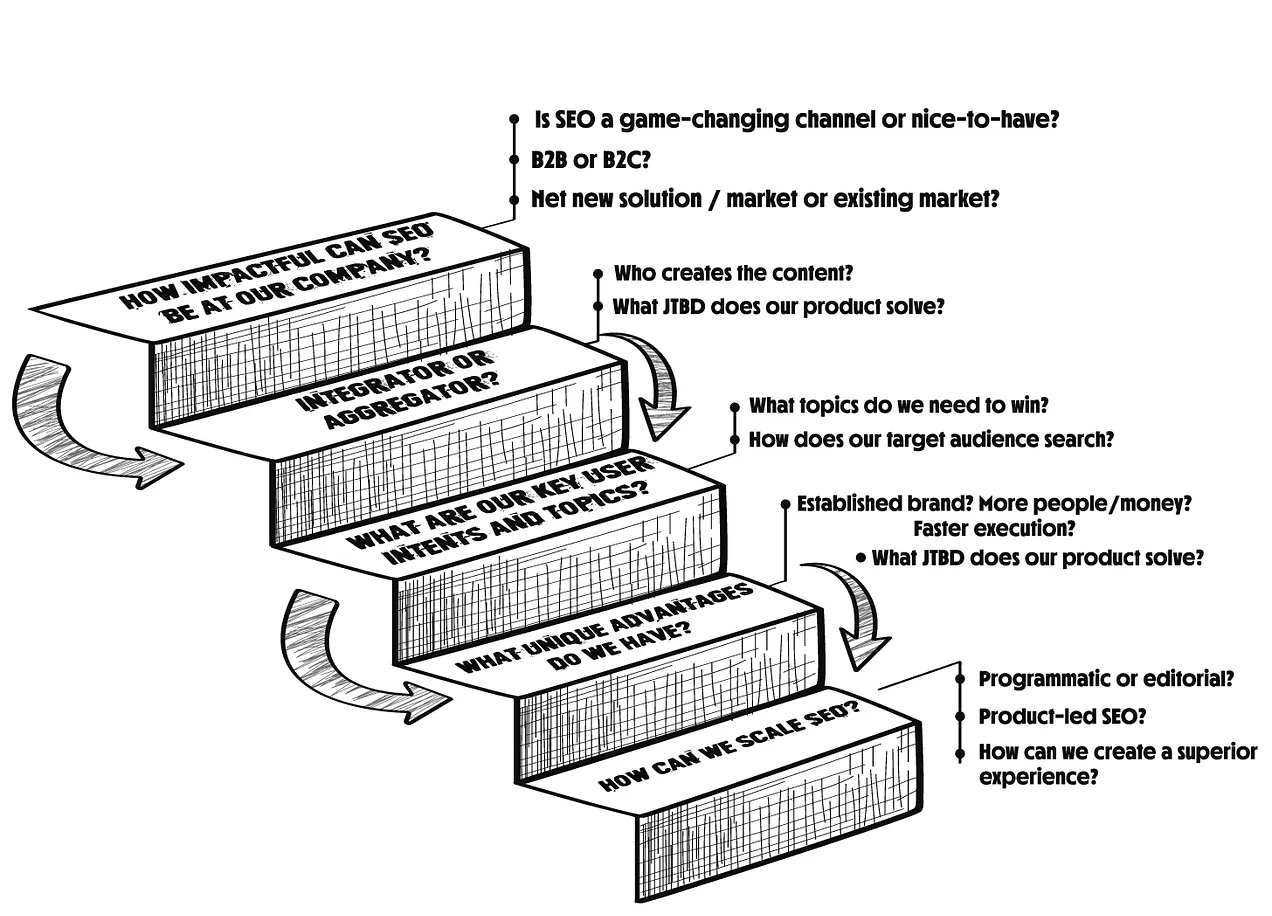 Image Credit: Lyna ™
Image Credit: Lyna ™Strategy is the most misunderstood topic in the SEO world and likely the most impactful one. Just search for “SEO strategy” and notice that almost every article is about tactics. I get it. Tactics are sexier.
HOWEVER, focusing on tactics without a strategy increases your risk of:
- Prioritizing the wrong tactics.
- Losing market share to newcomers.
- Missing critical opportunities and threats.
- Doing what others are doing instead of doing it better.
- Not getting buy-in for SEO from decision-makers or clients.
- Heart disease.
Okay, the last one might not be true. But the others are. I’ve seen it many times. It’s ugly.
In an environment of aggressive algorithm updates, fewer clicks due to AI Overviews and more SERP real estate taken by forums, you cannot afford to take those risks. And yet, everyone does. I’m no exception: After spending the last two years crafting SEO strategies for companies like Ramp, Reddit, Nextdoor, and Hims, I realized the article that previously occupied this URL was too tactical – and completely rewrote it.
I’ve seen the difference between no and elegant strategy. Good SEO strategies embody a framework that seizes the opportunity of change, focuses on leverage, and beautifully stacks tactics in a logical structure.
To bring strategy to the forefront of SEO, I’m sharing with you:
- A crisp definition of what strategy is and how it works.
- The 5-question framework I’ve been using to develop SEO strategies.
- Countless notes from books and practical experience I’ve taken over many years1
What An SEO Strategy Actually Is
Short definition: An SEO strategy defines how to overcome critical challenges by leveraging competitive advantages.
After years of not really getting it, I located the best definition of a business strategy in Richard Rummelt’s book “Good Strategy, Bad Strategy”. He explains that the kernel of strategy holds three parts:
- A diagnosis of key challenges to overcome
- Guiding policies that define how to overcome the challenges
- Coherent actions that implement policies
A myriad of strong examples convinced me that this is the framework to go – and to apply to SEO. I’m rewording Rummelt’s framework to make it more colorful and approachable:
- Challenge
- Approach
- Actions
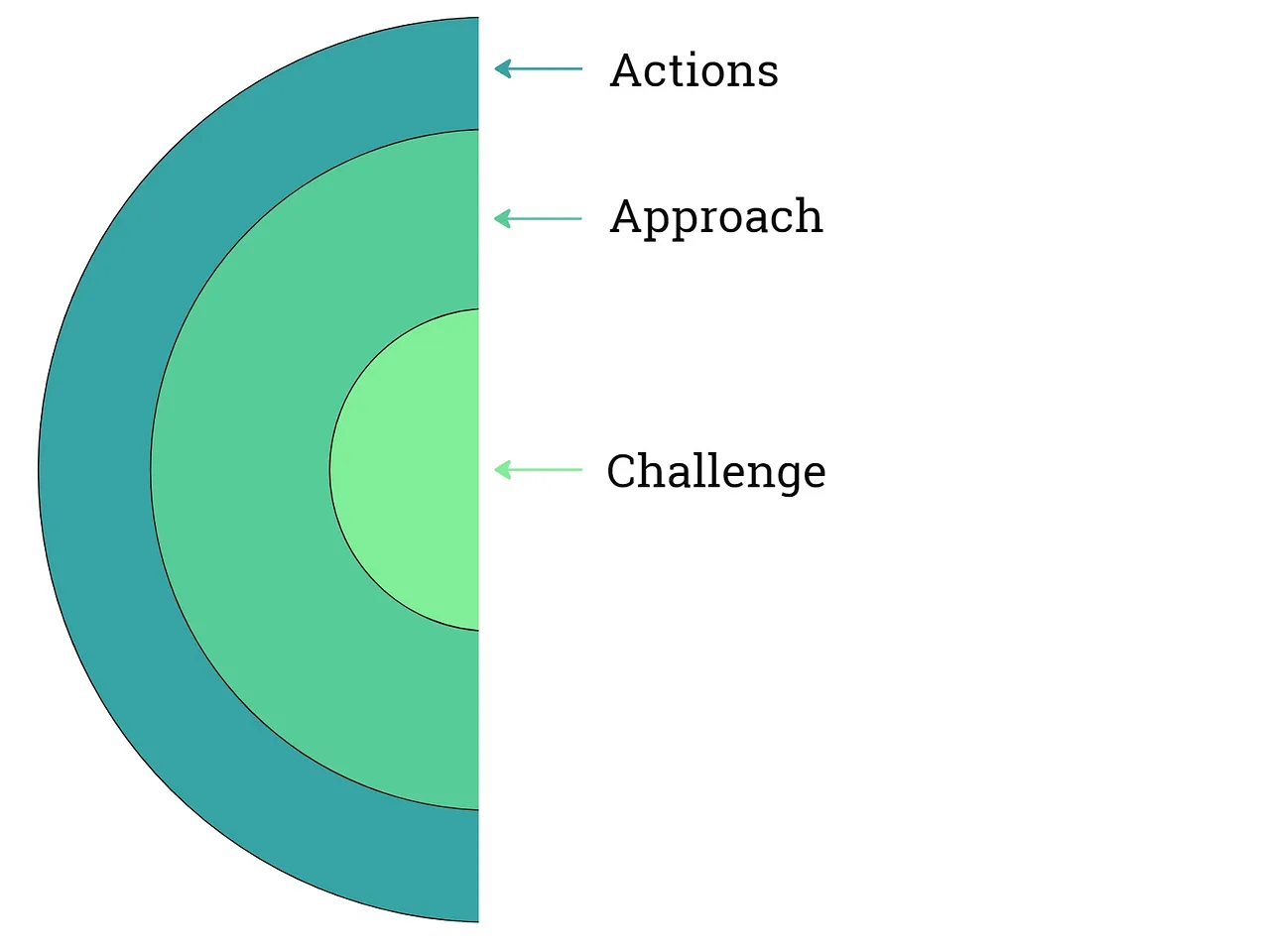 The SEO strategy kernel (Image Credit: Kevin Indig)
The SEO strategy kernel (Image Credit: Kevin Indig)Long definition: An SEO strategy clearly defines the Challenge a company must overcome through deep analysis. It concludes the direction in which the company needs to move to overcome that challenge in a framework called the Approach. Lastly, an SEO strategy defines specific Actions that must be taken to implement the Approach and overcome the Challenge. The Challenge remains constant, but the Approach can adjust, and Actions can change completely based on new information.
In his book “Originals”, Adam Grant even mentions that flexibility towards actions can be a strength:
Teams that evaluated their strategies at the midpoint were 80 percent more effective than teams that had the conversation at the start. […] This is one of the reasons that halftimes can be so influential in basketball and football: They allow coaches to intervene when teams are most amenable to new strategies.
You can tell a strategy is well thought-out based on four indicators:
- Layers: elements build on top of each other
- Exploit: maximization of a competitive advantage
- Simplicity: focus on overcoming the core challenge
- Change: capitalization of change in technology, competitors, consumer behavior and other areas
Boost your skills with Growth Memo’s weekly expert insights. Subscribe for free!
Challenge
The Challenge stands in the way of achieving your goals and embodies the “why” behind what you do. A strategy’s job is to find and solve the core challenge.
Defining the challenge is the most important part of a good SEO strategy because it’s the base for the direction and future actions. If you get this wrong, you waste a lot of time and money. To avoid failure, you need to invest in researching your market position, customers and competitors to understand the problems, their causes, and the ecosystems in which they occur.
Example: You aim to “win” the pet food SEO space but face established incumbents with more resources. After doing the research, you come to the conclusion that incumbents have outsized authority and relevance for pet food product names and category keywords.
Approach
The Approach is the “what” you do to overcome the core challenge. It’s a framework that sets the direction of your actions by exploiting your current advantages and exploring new ones. Getting the approach wrong means you lose focus and work on actions that don’t help you overcome the core challenge.
The Approach is an unambiguous list of the areas in which you invest and which you do not. Defining what you’re not going to do is equally as important as what you’re going to do because every strategy is a choice. That’s why my framework is called the 5 Choices. Without making hard choices, you likely don’t focus enough.
The Approach outlines your strategy risks, i.e., where the execution of your approach could go wrong. Every choice bears risk. By getting ahead of them, you minimize your chances of failing.
Critical: the approach needs to be differentiated. You need to do things differently (competitive advantage or asymmetry). You cannot expect to do the same things as your competitors and beat them. That’s just a way to end up in attrition warfare and obsession with operational efficiency. Differentiation creates greater value, prices and margins.
Sources of competitive advantages can be:
- Focus.
- Reputation.
- Network effects.
- Stronger tools/automation/systems.
- Being the first to do or notice something.
- A resource your competitors don’t have access to.
Example: To overcome the core challenge in the pet food space, you decide to leverage your strength of inhouse experts (say, you have a bunch of vets on staff). You invest in writing pet food guides instead of focusing on category and product landing pages. Traffic to the guides is funneled to landing pages where you sell your product.
Actions
Actions are “how” you implement the approach to overcome the core challenge. This is where it gets more tactical. But instead of picking “cool tricks” or “shiny objects”, your actions need to align with the approach and challenge. You know you’re there when your actions reinforce each other.
Example: Actions you could take to focus on pet food guides are publishing 100 pieces of content with detailed content briefs over the next 3 months, define a regular content refresh cadence and syndication to 10 industry magazines. You also create a video for each guide and position your site as a source of expert guidance from field practitioners.
Notice how you could have taken a different approach to solving the core challenge, like focusing on category and product landing pages. However, this approach would’ve likely not solved your core challenge because you know that strong incumbents already have a stronghold in that area. So, you need to do something different that plays into your strengths.
SEO Strategy Examples From Instacart, Substack, And Adobe
Instacart is a marketplace aggregator connecting buyers with supermarkets (read the full case study). Even though the company has been around since 2012, it encountered a defining moment when the COVID-19 pandemic broke out and consumers ordered groceries online.
- Challenge: Win the grocery market during the pandemic amid strong competition
- Approach: Target grocery and near-me keywords
- Actions: Build dedicated landing pages with rich snippet enhancements
Instacart’s approach was to capitalize on the trend as an aggregator instead of a supermarket chain. They tried to differentiate with inspirational editorial content but missed an opportunity to gain more visibility with recipes. Competitor Kroger regained the lead in 2022, and incumbent Costco is still far ahead.
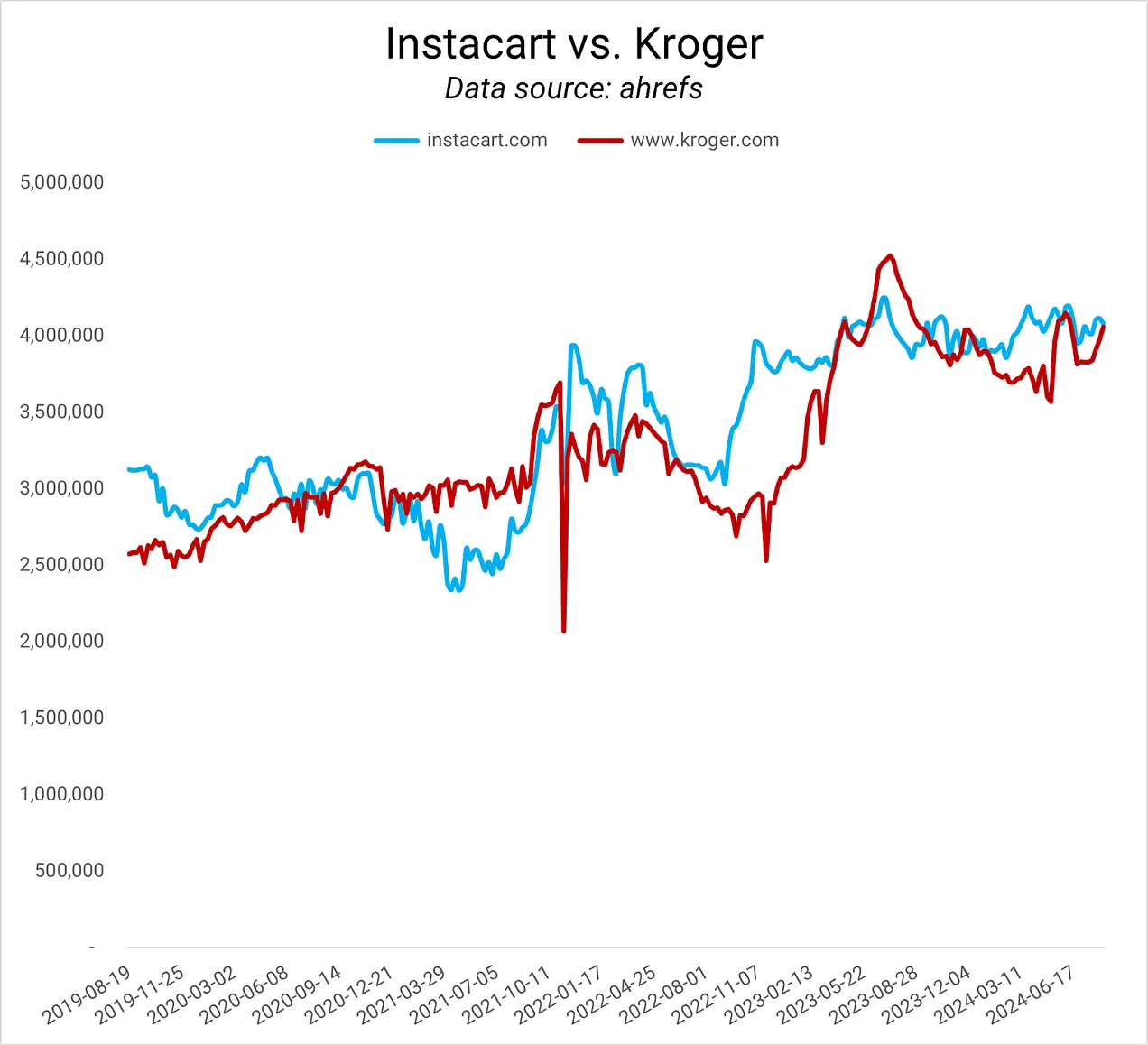 Image Credit: Kevin Indig
Image Credit: Kevin IndigSubstack is a newsletter and blog hosting platform (read the case study) for journalists and writers.
- Challenge: Host a critical mass of high-quality writers on its platform.
- Approach: Drive more traffic to publications by making the platform more Search-friendly.
- Actions: Indexable profile pages, optimized URLs, internal link modules and topical landing pages that serve as discovery hubs for newsletters to users and search engines.
Substack was able to catch up to WordPress in 2024 but is still far behind Medium, which had strong traffic declines between early 2021 and mid-2023.
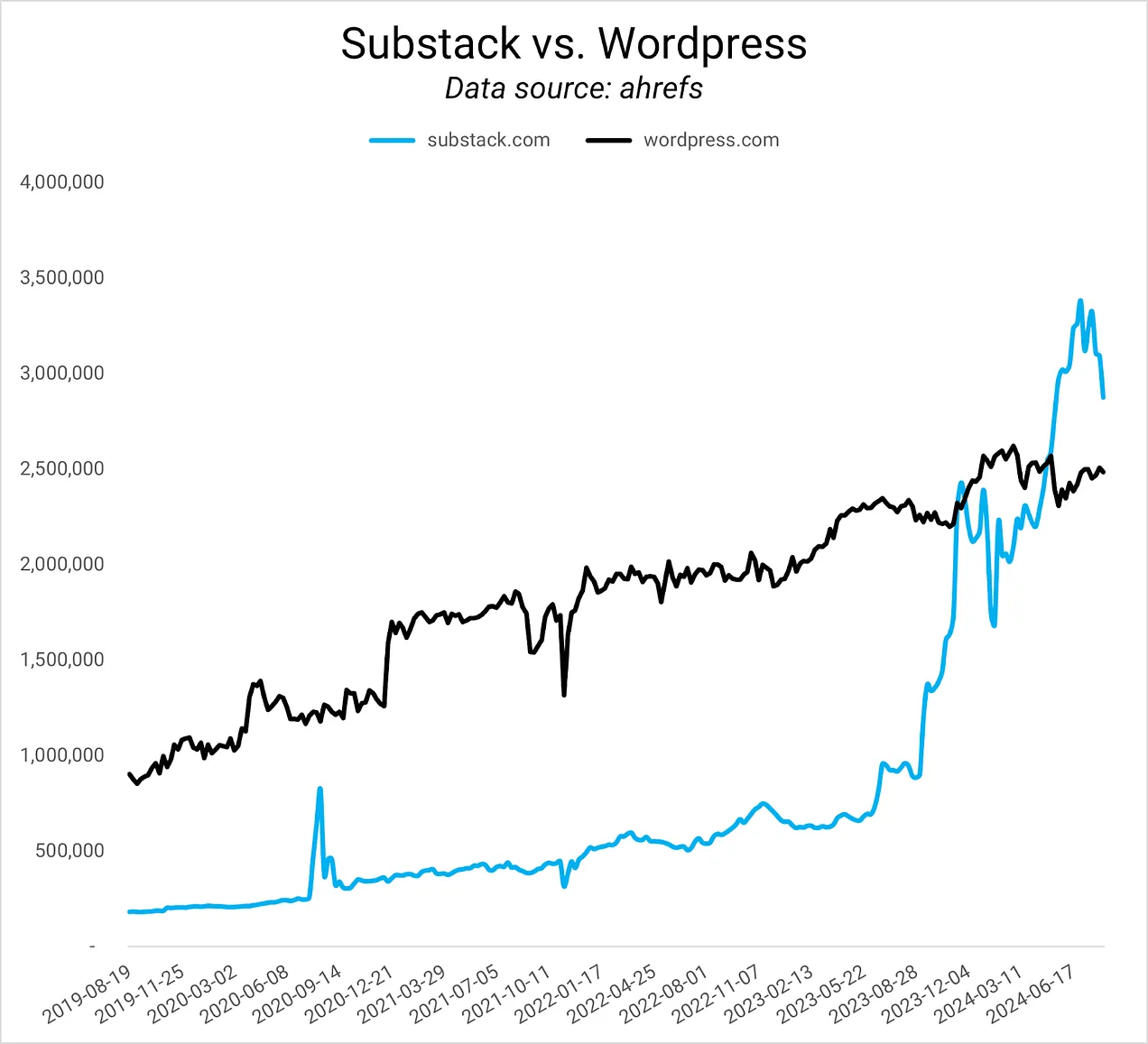 Image Credit: Kevin Indig
Image Credit: Kevin IndigAdobe is a legendary software solution for designers and marketers (read the case study). After many years of strong growth from editorial content and lead-gen tools, organic traffic plateaued, and competitor Canva grabbed more traffic share.
- Challenge: Break through the traffic plateau.
- Approach: Launch a stock photo platform to address a new user intent.
- Actions: Optimize stock photos and landing pages.
 Image Credit: Kevin Indig
Image Credit: Kevin IndigAdobe was able to recapture the top spot in organic traffic in 2024 after years of falling behind.
Non-SEO Example: Tesla
Tesla famously entered and captured the EV market with a luxury car instead of an affordable mass-market model. https://www.tesla.com/blog/secret-tesla-motors-master-plan-just-between-you-and-me Why?
- Tesla needed to build fewer cars and was able to refine its EV approach by targeting the luxury segment.
- Premium cars made it easier to finance R&D.
- Tesla established its brand and got many eyeballs by tapping into scarcity. Additional stunts, like designing the Roadster “to beat a gasoline sports car like a Porsche or Ferrari in a head to head showdown”, helped to build desire.
From there, the company always planned to go down-market and build cheaper ******. Today, Tesla has 50% market share.2
Simple and effective.
Don’t Mistake Tactics For Strategy
In my work as an inhouse leader and external advisor, I consistently come across four misunderstandings of SEO strategy:
1/ A strategy is not a set of tactics. As I explain in my free course Crafting a Winning SEO Strategy, “tactics are not defensible because they can be copied.” But for some reason, almost every article on the web about SEO strategy is all tactics and no strategy. Tactics are part of a strategy, but they are not the strategy.
I will never forget an executive at a renowned company saying, “This looks like we’re doing a bunch of stuff to me,” when I presented my “strategy”. The problem: I didn’t present the context (Challenge & Approach) in which the tactics make sense. And they didn’t. After taking a couple steps back, I re-evaluated my approach and presented a strategy that got us to win.
2/ A strategy is not a roadmap. A roadmap is a plan that defines which tactics are prioritized when and who executes them. Strategies lay out the playing field and how to win.
The following artifacts are plans, not strategies:
- Topic roadmaps
- Editorial calendars
- Content requirements
- Technical audits
- Annual goals
- etc.
3/ A strategy is not a goal. The strategy explains how to achieve a goal, but it doesn’t stop there. And a strategy is certainly not a number. Strategies lay out the decisions that have to be made to achieve a goal and how to make them.
4/ A strategy is not operational efficiency. Tactics, roadmaps and goals can be part of a strategy, but operational efficiency is a way to run an organization. I get the excitement to work on operational efficiency because it’s impactful and actionable.
When you confuse operational efficiency with strategy, you ultimately end up in an attrition game because you try to do what everyone else does better. The problem is that you won’t be able to catch up to incumbents who are lightyears ahead. The way out is a differentiated strategy.
The 5 Choices Of An SEO Strategy
So many SEOs fall back to tactics because there is no good SEO strategy framework on the web. My goal with this article is to give you a framework that’s easy to understand and implement so you can build your own strategy. I call it The 5 Choices.
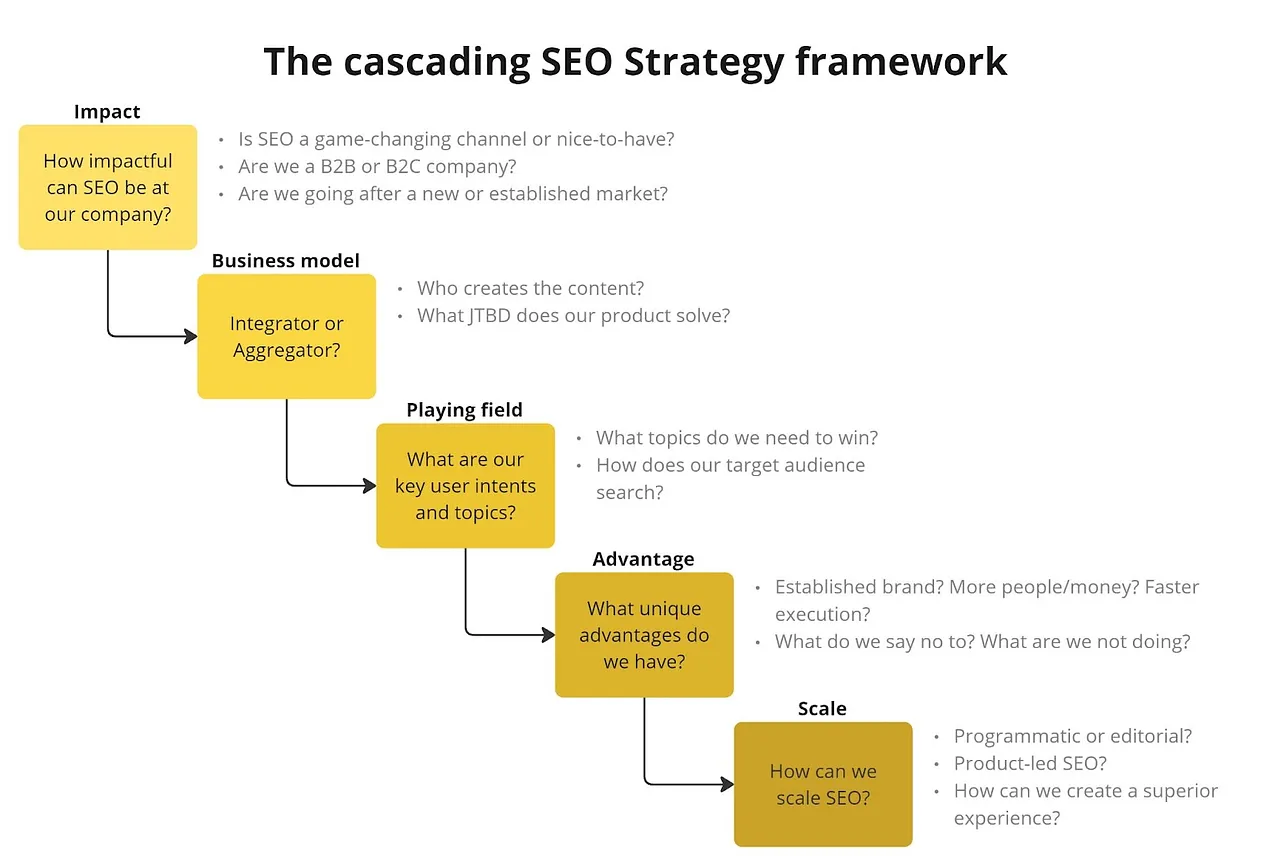 The 5 Choices (Image Credit: Kevin Indig)
The 5 Choices (Image Credit: Kevin Indig)The 5 choices are a set of vital decisions you must make to land at a differentiated SEO strategy by carving out your Challenge, Approach and Actions.
1/ How Impactful Can Seo Be At Our Company?
A strategy isn’t worth its bits if it ends up in a Dropbox folder. It must be applied. And to be applied, it must make an impact. If SEO cannot impact the company meaningfully, you likely won’t get enough buy-in and funding to execute a differentiated strategy. Potential impact determines your Challenge.
Measure impact in revenue. For example, the potential or current revenue contribution from SEO or the ability of incremental revenue from SEO with lower ad budgets.
To diagnose the (potential) impact of SEO, see if projected traffic and revenue over the next 6-36 months are meaningful to the company.
Key questions:
- Are we a B2B or B2C company?
- Are we competing in a net new or established market?
- Which channel drives most revenue?
Examples: High impact is when SEO accounts for 20% of the company’s revenue. Low impact is when search volume for key terms doesn’t translate into a meaningful opportunity.
2/ Integrator Or Aggregator?
The next question is whether the company is an SEO Integrator or Aggregator, based on who creates the content. If a company can scale SEO with user-generated content (UGC) or an inventory (e-commerce products, locations, or digital products), it’s an SEO aggregator. If a company creates the content “itself” with inhouse or freelance writers, it’s an SEO Integrator.
The difference is critical because each type scales SEO in its own way and has different levers in its arsenal, leading to distinct competitive advantages and approaches. Your type defines your Approach.
Key questions:
- Who creates the content?
- What JTBD does our product solve?
- Can we scale into aggregator plays as an Integrator or vice versa?
Examples: Instacart aggregates supermarkets and groceries, while Substack aggregates articles. Adobe is an integrator that built an aggregator arm with stock photos.
3/ What Key Intents And Topics Do We Focus On?
Early on, every company needs to focus on a few key user intents and topics to succeed in SEO. Over time, companies tend to fail in SEO when their domain carries too much content for topics they’re not yet known or an authority for. Topics and user intents can only expand with new products or features. Knowing which ones to focus on is a critical constraint for your Challenge and Approach.
Key questions:
- What topics align with our product(s), and which do we need to win?
- How does our target audience search?
To find key topics, look for which use cases best describe your product. Follow the jobs-to-be-done your product solves to find which user intents you can satisfy.
Examples: Airbnb targets people who search for activities and stays in cities (user intent) across core topics, such as short-term rentals, trips, and experiences. Adobe started as web design software and branched out into video and audio engineering, documents, marketing and e-commerce.
4/ What Unique Advantage(s) Do We Have?
Knowing your advantage is critical so you can fully lean into it. Sometimes hard to find, every company has at least one advantage based on its positioning, resources and product/market fit that determines how a company could combat a problem (Approach).
One part of leaning into your strengths is being clear about what you won’t do. Boundaries create focus and can be turned into strengths. Companies win by leveraging strengths, not fixing weaknesses.
From Jim Collins’ book “Good to Great”:
The good-to-great companies did not focus principally on what to do to become great; they focused equally on what not to do and what to stop doing.
Key questions:
- Where do we have an advantage?
- Do we have an established brand, more people/money, or faster execution?
- What do we say no to? What are we not doing?
To find advantages, look for inflexible structures competitors have to defend. Every strategic choice is a commitment that a competitor can position themselves against.
Examples: In my deep dive into the company Course Hero, I describe how its main competitor, Studocu, chose to compete by focusing on international markets before tackling the US. That is a very distinct strategic choice based on Studocu’s competitive advantage, the fact that Course Hero has established itself in the US, and
5/ How Can We Scale SEO?
There is no sustained impact without scale, whether you build more landing pages or hire more writers. Good strategies have force multipliers that compound returns over time with synergetic Actions.
Key questions:
- Programmatic or editorial?
- Product-led SEO?
- How can we create a superior experience?
To find scale mechanics, look for ways to create more high-quality pages on your domain and optimize your existing pages.
Examples: Local services aggregator Angi, for example, scales by consolidating its acquired companies into one domain and expanding editorial content with a large team.
How To Build An SEO Strategy Step By Step
Building your strategy is a 3 step process:
- Research/analyze.
- Document.
- Communicate.
Research/analyze
Your goal is to develop a razor-sharp understanding of the problem(s) you’re facing and to decide which one is the key problem based on thorough research:
- Audit your customers, market and competitors.
- Compare your assets, resources, and growth with competitors.
- Identify the gap between your current performance and goal.
- Use the 5x Why method for root cause analysis.
Document
Your strategy can be a written document or slide deck. The format itself is less important than compressing all the research and analysis into key paragraphs or slides.
Explain your reasoning in detail in the appendix or a separate document so that key partners understand where you’re coming from and why you come to your conclusions.
Communicate
The right way to communicate your strategy is with key partners first, ideally in person or virtually, and then with the broader company. Beat the drum on your strategy as often as you can with people at the forefront of execution. It takes a lot of repetition for the strategy to sink in, especially with larger companies.
Your strategy must be easy to understand. If it takes you 30 minutes and 100 slides to understand what the strategy is, you’re on the wrong track. Equally, if not every one of your employees can say what the strategy is, it’s likely not comprehensive enough.
First, you need clarity of the strategy for yourself, then you need to communicate it. – Bob Iger
The key to getting there is not to pick a simple strategy but to compress the hard work into its essence. A good example is how CEO Bob Iger simplified his strategy:
- Invest most of Disney’s resources into creativity
- Use technology to tell stories and reach people
- Grow globally
Conclusion: Strategy Is The Key To Powerful Tactics
In Growth Memo Premium, I dissect the strategies of Nike, The New York Times, Redfin, IBM and other successful companies. Each succeeds with a differentiated SEO strategy that leads them to either dominate their industry or challenge incumbents.
A strong strategy aligns the whole organization toward a core challenge. It puts tactics into context and creates synergies between them, which means you’re getting more impact out of them than if you started with tactics and backed up into strategy.
I’ll leave you with these provocative questions:
- What is a change you could leverage?
- Which strength have you underplayed?
- Do you have strong alignment between actions and approach?
- Do you know what the core challenge is you’re facing?
- Is your approach different from what others are doing?
Source link : Searchenginejournal.com
